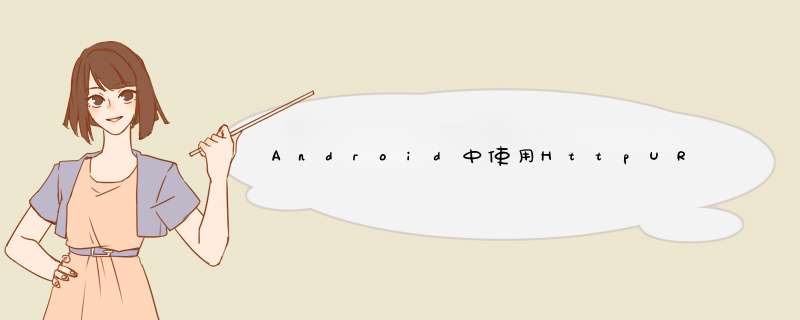
AndroID6.0中把Apache http ClIEnt所有的包与类都标记为deprecated不再建议使用所有跟http相关的数据请求与提交 *** 作都通过httpURLConnection类实现,现实是很多AndroID开发者一直都Apache http ClIEnt来做andoird客户端与后台http接口数据交互,小编刚刚用httpURLConnection做了一个androID的APP,不小心踩到了几个坑,总结下最常用的就通过httpURLConnection来POST提交JsON数据与GET请求JsON数据。此外就是下载图片,下载图片分为显示进度与不显示进度两种。其中提交数据的时候涉及中文一定要先把中文转码成utf-8之后在POST提交,否则就会一直遇到http 400的错误。
一、GET请求JsON数据的例子
public UserDto execute(String... params) { inputStream inputStream = null; httpURLConnection urlConnection = null; try { // read responseURLEncoder.encode(para,"GBK"); String urlWithParams = DOMAIN_ADDRESS + MEMBER_REQUEST_TOKEN_URL + "?username=" + java.net.URLEncoder.encode(params[0],"utf-8") + "&password=" + params[1]; URL url = new URL(urlWithParams); urlConnection = (httpURLConnection) url.openConnection(); /* optional request header */ urlConnection.setRequestProperty("Content-Type","application/Json; charset=UTF-8"); /* optional request header */ urlConnection.setRequestProperty("Accept","application/Json"); /* for Get request */ urlConnection.setRequestMethod("GET"); int statusCode = urlConnection.getResponseCode(); /* 200 represents http OK */ if (statusCode == 200) { inputStream = new BufferedinputStream(urlConnection.getinputStream()); String response = httpUtil.convertinputStreamToString(inputStream); Gson gson = new Gson(); UserDto dto = gson.fromJson(response,UserDto.class); if (dto != null && dto.getToken() != null) { Log.i("token","find the token = " + dto.getToken()); } return dto; } } catch (Exception e) { e.printstacktrace(); } finally { if (inputStream != null) { try { inputStream.close(); } catch (IOException e) { e.printstacktrace(); } } if (urlConnection != null) { urlConnection.disconnect(); } } return null; } 二、POST提交JsON数据
public Map<String,String> execute(NotificationDto dto) { inputStream inputStream = null; httpURLConnection urlConnection = null; try { URL url = new URL(getUrl); urlConnection = (httpURLConnection) url.openConnection(); /* optional request header */ urlConnection.setRequestProperty("Content-Type","application/Json"); dto.setCreator(java.net.URLEncoder.encode(dto.getCreator(),"utf-8")); // read response /* for Get request */ urlConnection.setRequestMethod("POST"); urlConnection.setDoOutput(true); DataOutputStream wr = new DataOutputStream(urlConnection.getoutputStream()); Gson gson = new Gson(); String JsonString = gson.toJson(dto); wr.writeBytes(JsonString); wr.flush(); wr.close(); // try to get response int statusCode = urlConnection.getResponseCode(); if (statusCode == 200) { inputStream = new BufferedinputStream(urlConnection.getinputStream()); String response = httpUtil.convertinputStreamToString(inputStream); Map<String,String> resultMap = gson.fromJson(response,Map.class); if (resultMap != null && resultMap.size() > 0) { Log.i("applyDesigner","please check the map with key"); } return resultMap; } } catch(Exception e) { e.printstacktrace(); } finally { if (inputStream != null) { try { inputStream.close(); } catch (IOException e) { e.printstacktrace(); } } if (urlConnection != null) { urlConnection.disconnect(); } } return null; } 三、下载图片显示下载进度
package com.example.demo; import java.io.ByteArrayinputStream; import java.io.ByteArrayOutputStream; import java.io.IOException; import java.io.inputStream; import java.net.httpURLConnection; import java.net.URL; import androID.graphics.Bitmap; import androID.graphics.BitmapFactory; import androID.os.AsyncTask; import androID.os.Handler; import androID.os.Message; import androID.util.Log; public class ImageLoadTask extends AsyncTask<String,VoID,Bitmap> { private Handler handler; public ImageLoadTask(Handler handler) { this.handler = handler; } protected voID onPostExecute(Bitmap result) { Message msg = new Message(); msg.obj = result; handler.sendMessage(msg); } protected Bitmap doInBackground(String... getUrls) { inputStream inputStream = null; httpURLConnection urlConnection = null; try { // open connection URL url = new URL(getUrls[0]); urlConnection = (httpURLConnection) url.openConnection(); /* for Get request */ urlConnection.setRequestMethod("GET"); int fileLength = urlConnection.getContentLength(); int statusCode = urlConnection.getResponseCode(); if (statusCode == 200) { inputStream = urlConnection.getinputStream(); byte data[] = new byte[4096]; long total = 0; int count; ByteArrayOutputStream output = new ByteArrayOutputStream(); while ((count = inputStream.read(data)) != -1) { total += count; // publishing the progress.... if (fileLength > 0 && handler != null) { handler.sendEmptyMessage(((int) (total * 100 / fileLength)) - 1); } output.write(data,count); } ByteArrayinputStream bufferinput = new ByteArrayinputStream(output.toByteArray()); Bitmap bitmap = BitmapFactory.decodeStream(bufferinput); inputStream.close(); bufferinput.close(); output.close(); Log.i("image","already get the image by uuID : " + getUrls[0]); handler.sendEmptyMessage(100); return bitmap; } } catch (Exception e) { e.printstacktrace(); } finally { if (inputStream != null) { try { inputStream.close(); } catch (IOException e) { e.printstacktrace(); } } if (urlConnection != null) { urlConnection.disconnect(); } } return null; } } 总结:使用httpURLConnection提交JsON数据的时候编码方式为UTF-8所有中文字符请一定要预先转码为UTF-8,然后在后台服务器对应的API中解码为UTF-8,不然就会报错http 400。
以上就是本文的全部内容,希望对大家的学习AndroID软件编程有所帮助。
总结以上是内存溢出为你收集整理的Android中使用HttpURLConnection实现GET POST JSON数据与下载图片全部内容,希望文章能够帮你解决Android中使用HttpURLConnection实现GET POST JSON数据与下载图片所遇到的程序开发问题。
如果觉得内存溢出网站内容还不错,欢迎将内存溢出网站推荐给程序员好友。
欢迎分享,转载请注明来源:内存溢出

 微信扫一扫
微信扫一扫
 支付宝扫一扫
支付宝扫一扫
评论列表(0条)